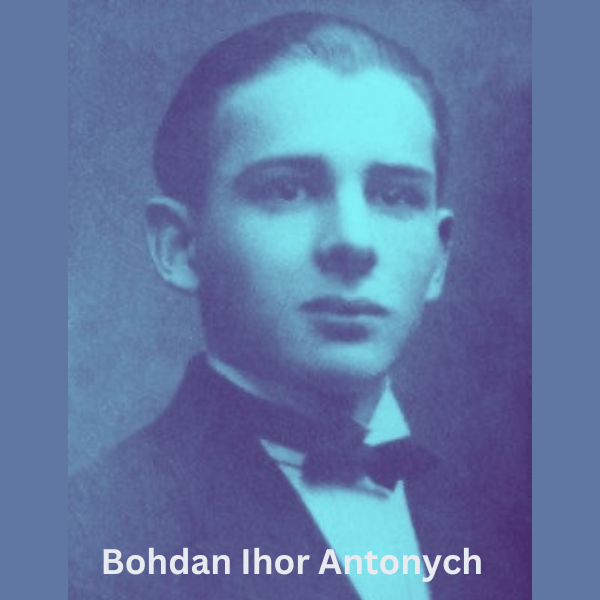Bohdan Ihor Antonych Ucrania (1909-1937). Poeta y Ensayista. Solo vivió 28 años. Gran poeta de su tiempo. Se dice que bebió del Folcklor y lo expresó en su poesía con el idioma original de los pueblos, esta lengua que usó el poeta se ha borrado casi en su totalidad. La comunidad étnica que el poeta expresaba fue destruida en la llamada operación Vístula. Lada Kolomiyets lee en Ucraniano.

TAFETAN ROJO Translated by Michael Naydan Bohdan Ihor Antonych (1909-1937) Supersticiones del pasado— de sueños brillantes-- queman como fogatas. La ciudad de mi juventud está en el tafetán rojo del ocaso. Las estrellas charlan en los chopos y la gente, afligida, se cruzan cuando Hassidim en negras sinagogas intentan apuñalar la luna con cuchillos ... Mi pueblo se hace misterioso tras la cortina de recuerdos juveniles! Y, de nuevo, la antigua juventud llama como llaman las viejas supersticiones. Spanish versión by Robert Lima *** RED TAFFETA Богдан-Ігор Антонич Bohdan Ihor Antonych (1909-1937) Superstitions of past ages-- of sparkling dreams burn like bonfires. The city of my youth is in the red taffeta of sunset. Stars chatter on poplars and people cross themselves in distress, when Hassidim in black synagogues stab at the moon with knives... My town is mysterious in the curtain of boyhood recollections! And again past youth calls the way old superstitions call. Translated by Michael Naydan ************** Червона китайка Горять, як ватра, забобони віків минулих – снів іскристих. В китайці заходу червоній моєї молодости місто. Лопочуть зорі на тополях і люди христяться з тривоги, коли ножами місяць колють хасиди в чорних синагогах. Моє містечко таємниче в хлоп’ячих споминів заслоні! І знов минула юність кличе, як давні кличуть забобони. 1936 ***
BOHDAN IHOR ANTONYCH (1909-1937)
Bohdan Ihor Antonych fue un poeta y ensayista extraordinariamente innovador originario de la montañosa región de Lemko (ahora en Polonia), donde se habla un dialecto de ucraniano influenciado por el polaco. Antonych se mudó a Lviv para estudiar en la Universidad de Lviv. Allí aprendió a escribir en ucraniano literario y cultivó su conocimiento de la cultura ucraniana. Su poesía revitalizó el vocabulario de la poesía ucraniana en la década de 1930, y fue extraordinariamente influyente en una serie de poetas ucranianos de los años 60 y 80, especialmente Yuri Andrukhovych, uno de los principales escritores ucranianos que escriben hoy. La poesía de Antonych abarca una serie de temas desde lo profundamente metafísico a lo mundano. A diferencia de las tendencias nacionalistas de varios poetas occidentales ucranianos en su época, el enfoque de Antonych era un arte por el arte, uno con principios estéticos elevados. Sus colecciones publicadas incluyen: Un saludo a la vida (1931), Tres anillos (1934), El libro del león (1936), El evangelio verde (1938) y Rotaciones (1938). Los dos últimos libros fueron publicados póstumamente. Otra colección de poemas sobre temas religiosos escrita en 1932, The Grand Harmony, se publicó por primera vez en su totalidad en 1967 en Nueva York.BOHDAN IHOR ANTONYCH (1909-1937)Bohdan Ihor Antonych fue un poeta y ensayista extraordinariamente innovador originario de la montañosa región de Lemko (ahora en Polonia), donde se habla un dialecto de ucraniano influenciado por el polaco. Antonych se mudó a Lviv para estudiar en la Universidad de Lviv. Allí aprendió a escribir en ucraniano literario y cultivó su conocimiento de la cultura ucraniana. Su poesía revitalizó el vocabulario de la poesía ucraniana en la década de 1930, y fue extraordinariamente influyente en una serie de poetas ucranianos de los años 60 y 80, especialmente Yuri Andrukhovych, uno de los principales escritores ucranianos que escriben hoy. La poesía de Antonych abarca una serie de temas desde lo profundamente metafísico a lo mundano. A diferencia de las tendencias nacionalistas de varios poetas occidentales ucranianos en su época, el enfoque de Antonych era un arte por el arte, uno con principios estéticos elevados. Sus colecciones publicadas incluyen: Un saludo a la vida (1931), Tres anillos (1934), El libro del león (1936), El evangelio verde (1938) y Rotaciones (1938). Los dos últimos libros fueron publicados póstumamente. Otra colección de poemas sobre temas religiosos escrita en 1932, The Grand Harmony, se publicó por primera vez en su totalidad en 1967 en Nueva York.
BOHDAN IHOR ANTONYCH (1909-1937)
Bohdan Ihor Antonych was an extraordinarily innovative poet and essayist originally from the mountainous Lemko region (now in Poland), where a dialect of Ukrainian influenced by Polish is spoken. Antonych moved to Lviv to study at the University of Lviv. There he learned to write in literary Ukrainian and cultivated his knowledge of Ukrainian culture. His poetry reinvigorated the vocabulary of Ukrainian poetry in the 1930s, and he was extraordinarily influential on a number of Ukrainian poets of the 1960s and 1980s, especially Yuri Andrukhovych, one of the leading Ukrainian writers writing today. Antonych’s poetry covers a number of themes from the profoundly metaphysical to the mundane. As opposed to the nationalist tendencies of a number of Western Ukrainian poets in his time, Antonych’s approach was an art for art’s sake one with high-minded aesthetic principles. His published collections include: A Greeting to Life (1931), Three Rings (1934), The Book of the Lion (1936), The Green Gospel (1938), and Rotations (1938). The latter two books were published posthumously. Another collection of poems on religious themes written in 1932, The Grand Harmony, was first published in its entirety in 1967 in New York.
Bibliographic information:
| Title | Hundred years of youth: a bilingual anthology of 20th century Ukrainian poetry |
| Editors | Olʹha Luchuk, Michael M. Naydan |
| Publisher | Litopys, 2000 |
| Original from | the University of Michigan |
| Digitized | Apr 30, 2008 |
| Length | 877 pages |


